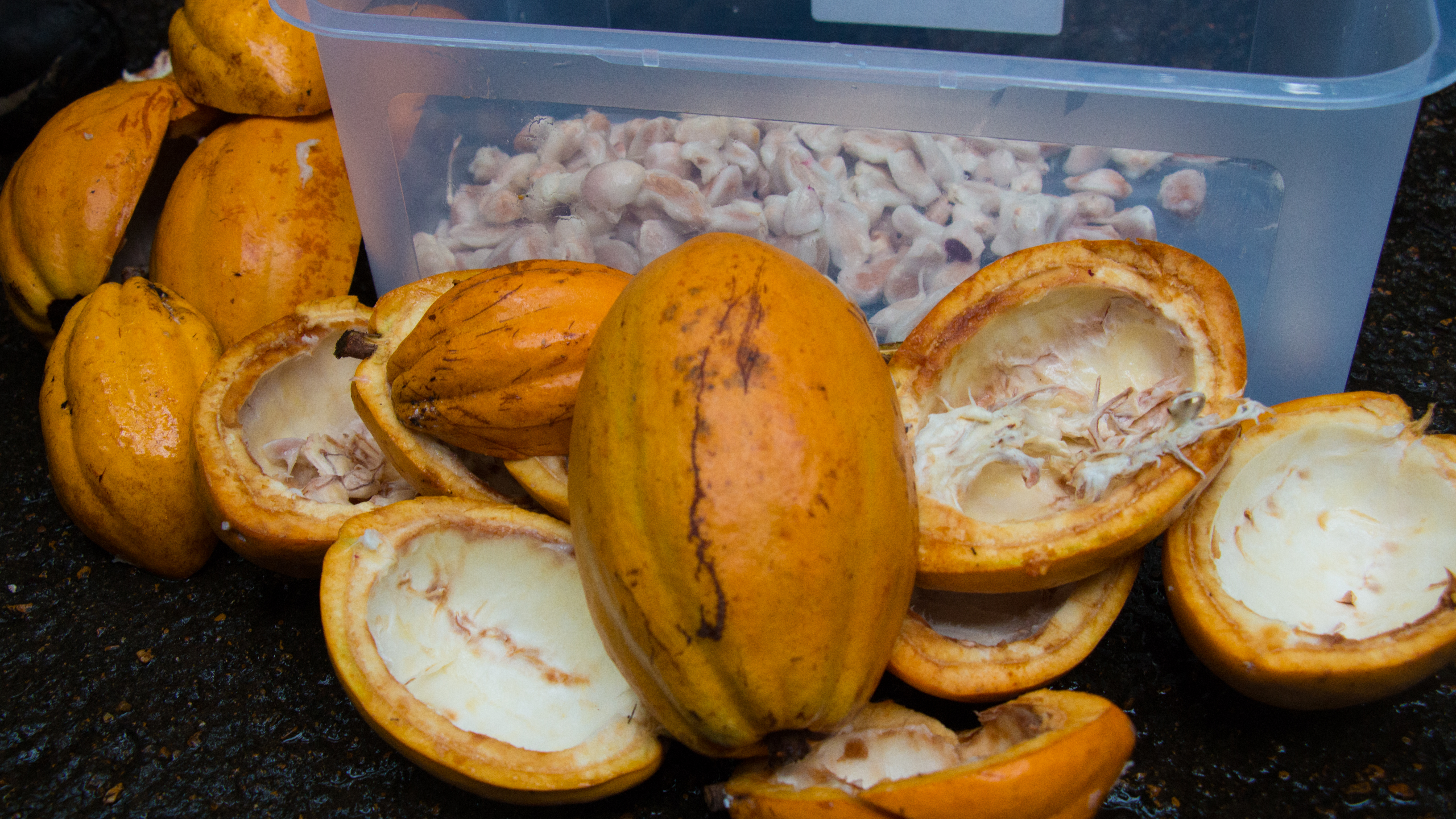Valentine’s Day is just around the corner, which means that many people will be seeking out chocolates and other candies for their loved ones. This is a great opportunity to shop sustainably! Check out some recommendations for sustainable chocolate from the EarthWays Center.
Where Does Your Chocolate Come From?
Chocolate is derived from the seeds of the cacao tree (Theobroma cacao). Cacao is a tropical, rainforest evergreen that can typically only grow close to the equator. It is an understory tree that grows under heavy canopy. These shade conditions help retain moisture, control temperature, suppress ground weeds, and maintain soil health due to a thick layer of leaf cover. However, much of the cacao currently grown in Africa and Central and South America is grown in at least partial sunlight.
Why is this shade tree being grown in the sun? In the short term, growing cacao plants in more direct sun can produce higher yields. Direct sun can also prevent some of the more common diseases found on trees. In the past 20 years, Côte d’Ivoire has turned into the single biggest producer of cacao, holding about 40% of the world market. Many of these farms go through 20- to 25-year boom-and-bust cycles. Rainforest is cleared and then cacao is planted along with other crop plants, such as banana. After 20 or so years, yield drops as does soil quality and the plantation is abandoned for another area of clear cutting. These practices decrease biodiversity in an area that is considered a biodiversity hotspot. They can also increase the need for pesticides and herbicides and decrease the fertility of the soil.
Growing cacao is very labor-intensive and can expose workers to dangerous conditions. Since the trees are in a tropical climate, they produce ripe pods for long harvest seasons which means that growers spend a lot of time examining their trees for ripe pods. Machetes or long-handled knives are often used to remove the pods from the trees. After the pods are harvested, they have to be cracked open and the seeds removed to ferment. After fermentation, the seeds are set out in the sun to dry. Then they are ready to be roasted and processed into cocoa powder and chocolate.
What is Sustainable Chocolate?
When examining whether something is sustainable, it is important to look at the “triple bottom line” or “3Ps” of sustainability: people, planet, and profit.
- People—Workers growing and processing chocolate should be treated fairly, protected from particularly dangerous work, and have access to safe living conditions.
- Planet—Rainforests in these ecologically precious regions are protected through maintaining soil health and biodiversity when chocolate is sustainably shade-grown.
- Profit—Companies that produce chocolates and candies want a product that will make them money and growers need to make a living wage.
Balancing all three of these interests helps to create a sustainable product, which is easier said than done. There are a number of organizations that help to certify chocolate as sustainable. Each group looks at it in a slightly different way.

Fair Trade certifies many products, including chocolate. Fair Trade has different standards for each industry, but much of its focus is on supporting the impoverished communities that create each product and on creating transparent supply chains.

Rainforest Alliance focuses specifically on products that are grown or harvested in the rainforest. In agricultural settings, it specifically focuses on biodiversity conservation, improved livelihood and human well-being, natural resource conservation, and effective planning and farm management systems.

The Roundtable on Sustainable Palm Oil (RSPO) is an organization that specifically certifies products and companies based on how they source palm oil. Palm oil is the most widely produced edible vegetable oil and it can be found in so many products. It is mainly grown in Indonesia and Malaysia. Oil palm is the most productive oil plant, producing five to ten times more oil per acre than soy or canola. The problem is that rainforest is often cut down to grow oil palm, pushing endangered rainforest species closer to extinction. The RSPO certifies companies and plantations if they minimize impact on wildlife and workers, have decent housing, wages, and health clinics.

Both the St. Louis Zoo and Cheyenne Mountain Zoo have created resources to help consumers buy chocolate and other products that contain sustainable palm oil. Use these guides to find candy and ice cream that contain sustainably harvested palm oil, and download the Cheyenne Mountain Zoo’s app to scan products and see if they are RSPO-certified.
Sustainable Chocolate in St. Louis
As you’re shopping for your Valentine’s Day sweets, make sure to look for any of the certifications mentioned above. If you are a St. Louis resident, check out the local restaurants and stores certified by the Green Dining Alliance (GDA). Kakao in Maplewood and Bailey’s Chocolate Bar have both received 5-star ratings from the GDA for sustainable practices, including waste reduction and energy and water conservation.
Find some great chocolates and candy this season—there is no need to sacrifice your commitment to your sweet tooth or sustainability this Valentine’s Day.
Maggie McCoy
EarthWays Center

Leave a Reply